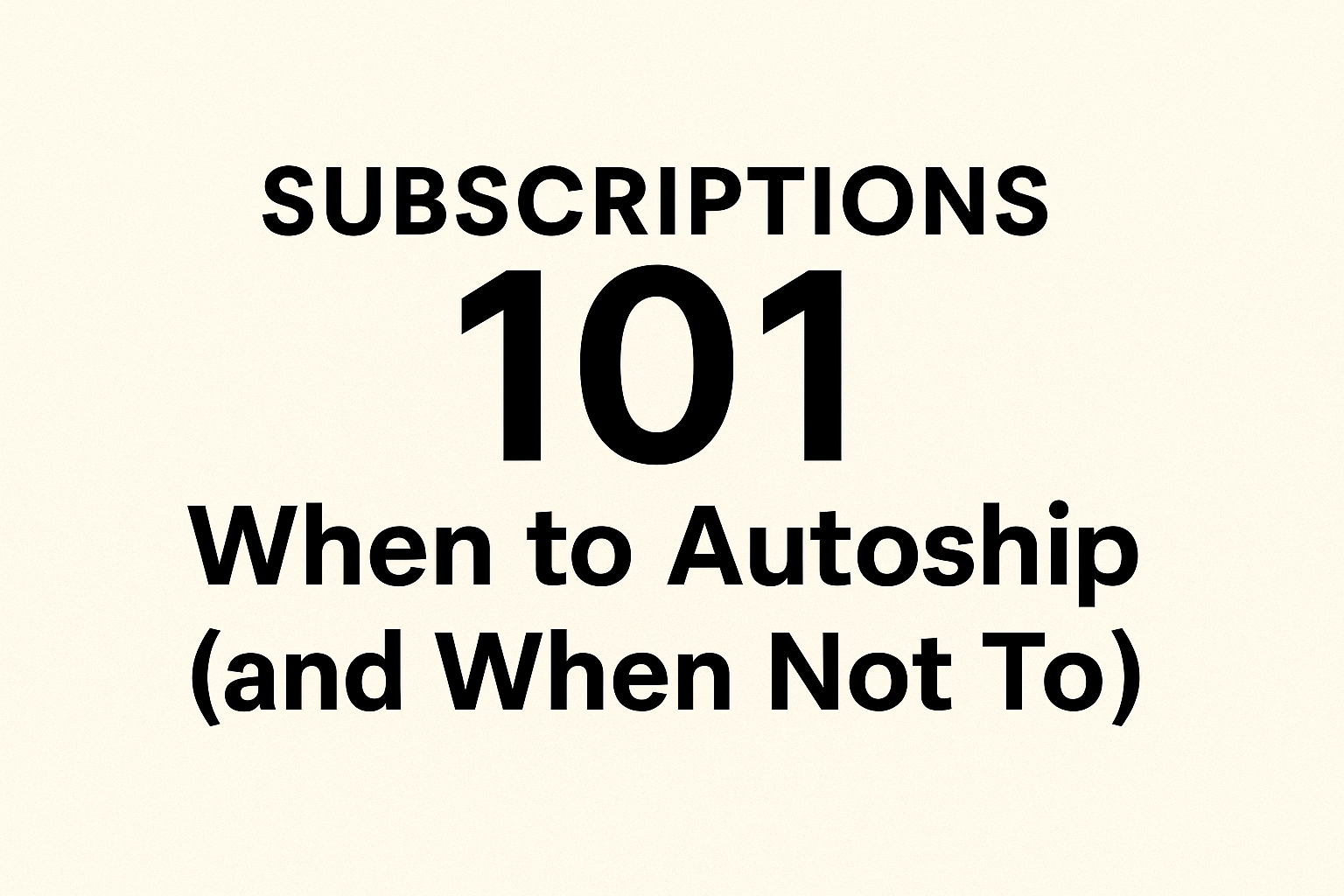Autoship subscriptions promise predictable revenue, better retention, and less friction for the customer. But not every product belongs in a recurring delivery cycle. Push it too early or too broadly, and you risk churn, customer frustration, and unnecessary returns.
This guide outlines when autoship makes sense, when it should be avoided, and how to build a model that protects your brand and serves your customers.
What Is Autoship?
Autoship is an order model where products are shipped on a recurring basis, such as every 30, 60, or 90 days. Customers are billed automatically until they cancel, pause, or adjust the schedule. For brands, it offers long-term value and operational visibility. For customers, it reduces decision fatigue and saves time.
The key is product suitability. Not every item benefits from automation, and not every customer wants it.
When Autoship Works
Routine replenishment products
Products consumed at regular intervals are strong candidates for autoship. These include:
- Vitamins and supplements
- Pet food and treats
- Personal care items like toothpaste or shampoo
- Cleaning supplies
- Certain grocery items
If the average customer finishes a unit in 30 to 45 days, a replenishment cycle adds convenience rather than friction.
Low-variation essentials
Items that don’t change often, like detergent pods, coffee filters, or contact lenses, work well because the customer doesn’t need to rethink their order each time. They know what they want, and they don’t need to be sold again.
In industries like cannabis and wellness, this has extended to top thc drinks and microdose gummies. Frequent users prefer staying stocked without the risk of running out or overbuying.
Loyalty-driven categories
If your audience builds routines around your product , such as skincare, nootropics, or performance supplements, autoship keeps that behavior in motion. These customers often view the subscription as a service rather than a sales tactic.
When Autoship Fails
One-time novelty products
Autoship does not work for items purchased out of curiosity or for special occasions. Examples include unique flavors, seasonal products, or limited-edition items. These tend to be irregular purchases and should not be locked into a schedule.
Instead, let customers opt in when ready. Consider curated bundles or promotional reorder campaigns that build anticipation rather than obligation.
Inconsistent usage patterns
If your product has highly variable usage , such as hair masks, protein powders, or niche supplements , customers may not need a refill every 30 days. Pushing a fixed interval increases the chance of surplus, returns, or subscription fatigue.
These items benefit from smart reordering emails, refill reminders, or build-your-own subscription tools that let customers match delivery to actual need.
Perishables or high-ticket items
Expensive products or those with a short shelf life require more intentional purchasing. If customers receive these items too early, you risk spoilage or refund requests.
In these cases, autoship should be optional, flexible, and easy to cancel. A membership model with reorder perks might be a better long-term fit.
Signs Your Product Is Not Ready for Autoship
- High unsubscribe rate after the second delivery
- Frequent skips, pauses, or order cancellations
- Negative support feedback about too-frequent shipments
- Refunds due to overstocking or expiration
These are operational signals. They mean your autoship model may not align with customer expectations or usage behavior.
Alternatives to Traditional Autoship
If full automation doesn’t fit, consider the following:
Reminder-based replenishment
Trigger an email or SMS when a customer is likely to need a refill. This works well for variable-use items and keeps the decision in the customer’s hands.
Flexible frequency subscriptions
Let customers choose their delivery interval , not everyone wants a 30-day cycle. Offering 45, 60, or even 90-day options can dramatically reduce churn.
Membership access
Offer perks such as discounted shipping, loyalty points, or early access without requiring recurring delivery. This builds retention without the risk of overdelivering.
Manual reordering perks
Give customers a reason to come back with one-click reordering and loyalty discounts, especially when usage patterns vary.
Best Practices for Autoship Success
- Keep the customer in control. Make it easy to pause, skip, or cancel.
- Send reminders before billing or shipping.
- Reinforce the benefit, convenience, savings, or both, in every touchpoint.
- Review your data monthly. Look for drop-offs after delivery one or two.
Subscription success comes from respect, not rigidity. Customers stay when they feel the model serves them, not the other way around.
FAQs
What kinds of products are best suited for autoship?
Products with predictable, consistent usage. Think vitamins, pet food, or toothpaste.
What if my product is used inconsistently?
Offer a flexible schedule or use refill reminders instead of fixed intervals.
How can I reduce churn in my subscription program?
Allow customers to adjust frequency, skip shipments, and manage their own schedule. Always communicate before billing.
Is autoship right for premium or expensive items?
Sometimes. If the product is a true essential for the buyer, yes. Otherwise, offer manual reordering or value-based memberships.
When should I avoid autoship altogether?
If your product is novelty-driven, perishable, or highly personalized, avoid forcing it into a recurring model. Let the customer opt in each time.


